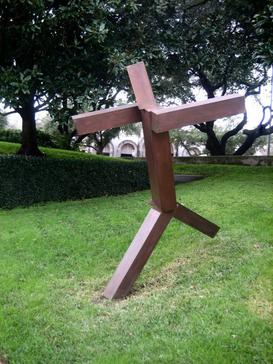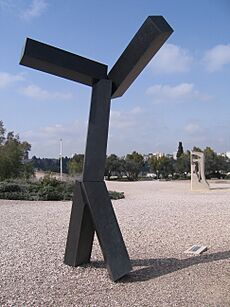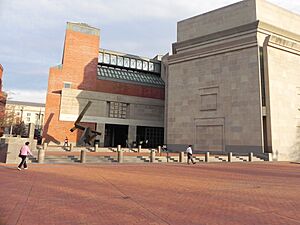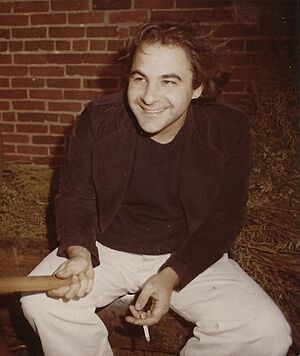Joel Shapiro facts for kids
Joel Elias Shapiro (born September 27, 1941 – died June 14, 2025) was an American sculptor. He was known for creating sculptures made from simple, rectangular shapes. Art experts often called his style "Postminimalist," which means his art came after the very simple "Minimalist" art movement.
Shapiro's sculptures were special because of the materials he used, like bronze or wood. They usually didn't try to show specific people or things. His artworks can be found in important museums and public places all over the world. Many of his sculptures are simply called Untitled. One of his most famous works, Loss and Regeneration (1993), was made for the United States Holocaust Memorial Museum in Washington, D.C.
| Top - 0-9 A B C D E F G H I J K L M N O P Q R S T U V W X Y Z |
Joel Shapiro's Life and Art Journey
Early Life and School
Joel Shapiro was born in New York City on September 27, 1941. He grew up in a neighborhood called Sunnyside, Queens. His father was a doctor, and his mother was a microbiologist. Both of his parents went to New York University. His mother also enjoyed making clay figures as a hobby.
When he was young, Joel loved art, but he also thought about becoming a doctor like his father. He finished high school in Bayside, New York, in 1959.
Discovering Art in India
After college, when he was 22, Joel lived in India for two years. He was part of the Peace Corps, a group that helps people in other countries. This time in India was very important for him. He said it made him realize how big and varied life is. It also made him feel that becoming an artist was truly possible for him.
He later earned a master's degree from New York University in 1969.
Starting His Art Career
Shapiro worked at the Jewish Museum, helping to set up art shows. In 1969, his work was shown in an important exhibition at the Whitney Museum. This show helped define the "Post-Minimalist" art movement.
His first solo art show was in 1970 at the Paula Cooper Gallery in New York City. There, he showed small sculptures of houses and chairs made from cast iron and bronze. These small, solid objects were a surprise because most art at the time was very large and abstract.
Joel Shapiro's art was also shown at the first exhibition of the Clocktower Gallery in 1973. This gallery later became the P.S.1 Contemporary Art Center, a well-known art space. In 1982, the Whitney Museum held a big show looking back at all of his work. He joined the Pace Gallery in 1992 and had many solo exhibitions in New York and other countries.
Family Life
Joel Shapiro lived and worked in New York City. He first married Amy Snider, who started an art education program at the Pratt Institute. They had a daughter named Ivy, who became an art adviser. They separated in 1972.
In 1978, Joel married another artist named Ellen Phelan. They lived in Long Island City, where they had a large art studio in an old electric building.
Joel Shapiro passed away on June 14, 2025, at the age of 83. He died from a type of blood cancer.
What Inspired Joel Shapiro's Art?


When Joel Shapiro was in India with the Peace Corps, he saw a lot of Indian art. He felt that art in India was everywhere and a big part of society. He said that his own art tried to find shapes that showed real feelings, much like Indian sculptures.
His early artworks were sometimes described as small. However, Shapiro explained that they were "all about scale." He meant that even small things can feel very big or important depending on how you experience them. He wanted these early works to show his own feelings of longing or desire.
From Simple Shapes to Moving Forms
By the 1980s, Shapiro started making larger sculptures. These pieces still reminded people of Indian and Greek art, but they also took ideas from early modern artists like Edgar Degas. Many of these bigger artworks were made for museums and galleries.
Later, Shapiro began to create sculptures that looked like human figures in motion. His art showed people dancing, crouching, or falling. These works explored ideas like balance, how things can stick out (cantilever), and how they can be pressed together. His later sculptures sometimes looked like they were flying or floating in the air, almost defying gravity.
He said he wanted his art to stand on its own and not be limited by buildings or the ground. For example, he made a large bronze sculpture for the Hood Museum of Art. This tall, thin piece leans over a walkway, and its almost-falling shape makes the museum's courtyard feel more energetic. Like most of his later works, this sculpture is also called Untitled.
Jewish Heritage and the Color Blue
Joel Shapiro was Jewish, and his Jewish traditions influenced his art. He often used the color blue in his works. Some people have compared his art to that of Alberto Giacometti, another famous sculptor whom Shapiro admired.
Most of Shapiro's sculptures are called Untitled. He explained this by saying, "I'm not much of a poet. Form is its own language." This means the shapes and materials of his art speak for themselves.
Where to See Joel Shapiro's Art

Joel Shapiro's sculptures are in many important collections around the world. Here are a few examples:
In the United States
- California: Museum of Contemporary Art San Diego, Museum of Contemporary Art, Los Angeles, Fine Arts Museums of San Francisco, J. Paul Getty Museum.
- District of Columbia: National Gallery of Art, Hirshhorn Museum and Sculpture Garden, United States Holocaust Memorial Museum (where Loss and Regeneration is located), Kennedy Center.
- Florida: Boca Raton Museum of Art, Norton Museum of Art.
- Illinois: Governors State University.
- Iowa: Principal Riverwalk, Pappajohn Sculpture Park.
- Massachusetts: Fogg Art Museum at Harvard University, Museum of Fine Arts, Boston.
- Michigan: Detroit Institute of Arts, Frederik Meijer Gardens & Sculpture Park.
- New York: Museum of Modern Art (MoMA), Whitney Museum, Storm King Art Center, Rockefeller University.
- Texas: Dallas Museum of Art, Nasher Sculpture Center, Museum of Fine Arts, Houston, Rice University Art Gallery.
Around the World
- Australia: National Gallery of Australia in Canberra.
- Canada: Embassy of the United States of America in Ottawa.
- Denmark: Louisiana Museum of Modern Art.
- Germany: Skulpturen Park Köln.
- Israel: Tel Aviv Museum of Art, Israel Museum in Jerusalem.
- Italy: Peggy Guggenheim Collection in Venice.
- Netherlands: Westersingel sculpture trail in Rotterdam.
- United Kingdom: Tate in London.
Awards and Recognition
Joel Shapiro was recognized for his artistic achievements. He became a member of the Royal Swedish Academy of Fine Arts in 1994. In 1998, he joined the American Academy of Arts and Letters, and in 2012, the National Academy of Design.
See also
 In Spanish: Joël Shapiro para niños
In Spanish: Joël Shapiro para niños


